This image depicts each of the southern states riding various animals off a cliff. This is supposed to signify how the southern states' decision to secede from the Union was comparable to driving themselves off a cliff.
Teachers, need a primary source to create a lesson in the classroom? Students, need a source for a research project?
Here, we've listed the primary sources featured in our Unit Plans. Click on a primary source to go to its page, where you may find additional images, transcriptions of the text, a citation guide for including the source in a bibliography, or ways to purchase copies of the source for the classroom.
HSP's collections are not limited to the primary sources listed here. To see all that HSP has to offer, come visit us or explore our collection online through the Digitial Library and the Discover online catalog.
Some sources have handwriting that is difficult to read. If you need help decoding handwriting, check out this guide from Ancestry.
 |
 Castle Garden was America's first official immigrant center with over 11 million immigrants passing through between 1820-1892. This cartoon depicts the vices which could 'trap' immigrants as they entered the United States. |
 This cartoon illustrates the fear that immigrants will bring death and disease with them to American shores. Death is shown on board the ship carrying a scythe and the caption reads, "The Kind of 'Assisted Emigrant' We Can Not Afford to Admit." |
 The preamble to the Constitution of the General Assembly of the Knights of Labor, which outlines the background and goals of the group, was published in 1888. |
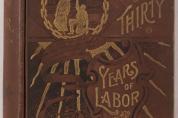 Terernce Powderly wrote Thirty Years of Labor in 1880 to document the causes that led to the formation of the Knights of Labor and its work as well to discuss its ideals. |
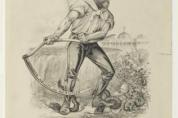 This image depicts President James Garfield cutting his way to the White House using honesty, ability, and patriotism. Meanwhile, he is cutting through his political opponents, which are made up of malice, fraud, and hatred. |
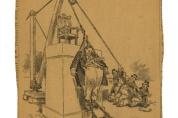 This political cartoon shows President Taft held down with huge weights which read "Record of the Republican Party" and "Industrial Depression." Meanwhile, oil, wool, and steel trusts are attempting to hoist his very large body up onto a pedestal with a throne attached that represents the presidency. |
 This political cartoon depicts "public vice" being swept out of the White House. Each of the rats chased out has a little note attached to it, which say gambling, vice, and graft. |
 This political cartoon shows President Lincoln and Jefferson Davis pulling at a map of the United States as it is ripping in half. Meanwhile General McClellan, Mac, stands in the middle attempting to stop it. This represents the Civil War and McClellan's stance that preserving the Union should come first. |
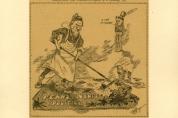 This cartoon illustrates Governor Pennypacker cleaning up Pennsylvania politics. In the illustration, he is depicted scrubbing the state with 'decent politics suds' and removing the stains from the map. |
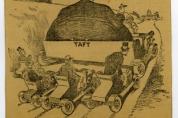 This political cartoon features President William Taft on his way to the White House. Taft will constantly be remembered for his large size, and this cartoon illustrates him blocking the political opposition with his large body. |
 This political cartoon was created by Ben Franklin and it depicts a snake cut into several pieces. Each piece represents a colony. Franklin created it to show the colonists that unity was necessary for survival. |
- ‹ previous
- 11 of 22
- next ›